Technology Implementations for Independent Living in Health Care
VerifiedAdded on 2023/06/14
|19
|4813
|59
Report
AI Summary
This report examines the role of technology in supporting independent living, focusing on its application within health and social care contexts. It discusses how technology can assist individuals like Sally, who faces challenges due to medical conditions, by providing adaptive tools and devices such as PDAs, specialized keyboards, and modified vehicles. The report also addresses barriers to technology adoption, including cost, training, and user acceptance, while highlighting the benefits for patients, families, and healthcare organizations. Furthermore, it explores health and safety considerations, ethical implications, and the impact of emerging technologies on healthcare services, recommending appropriate assistive devices to support independent living for users like Maggie. The report emphasizes the importance of technology in enhancing the quality of life and promoting autonomy for individuals with diverse needs, making it a valuable resource for students and professionals in the healthcare field. Desklib provides a platform to access similar solved assignments and past papers.
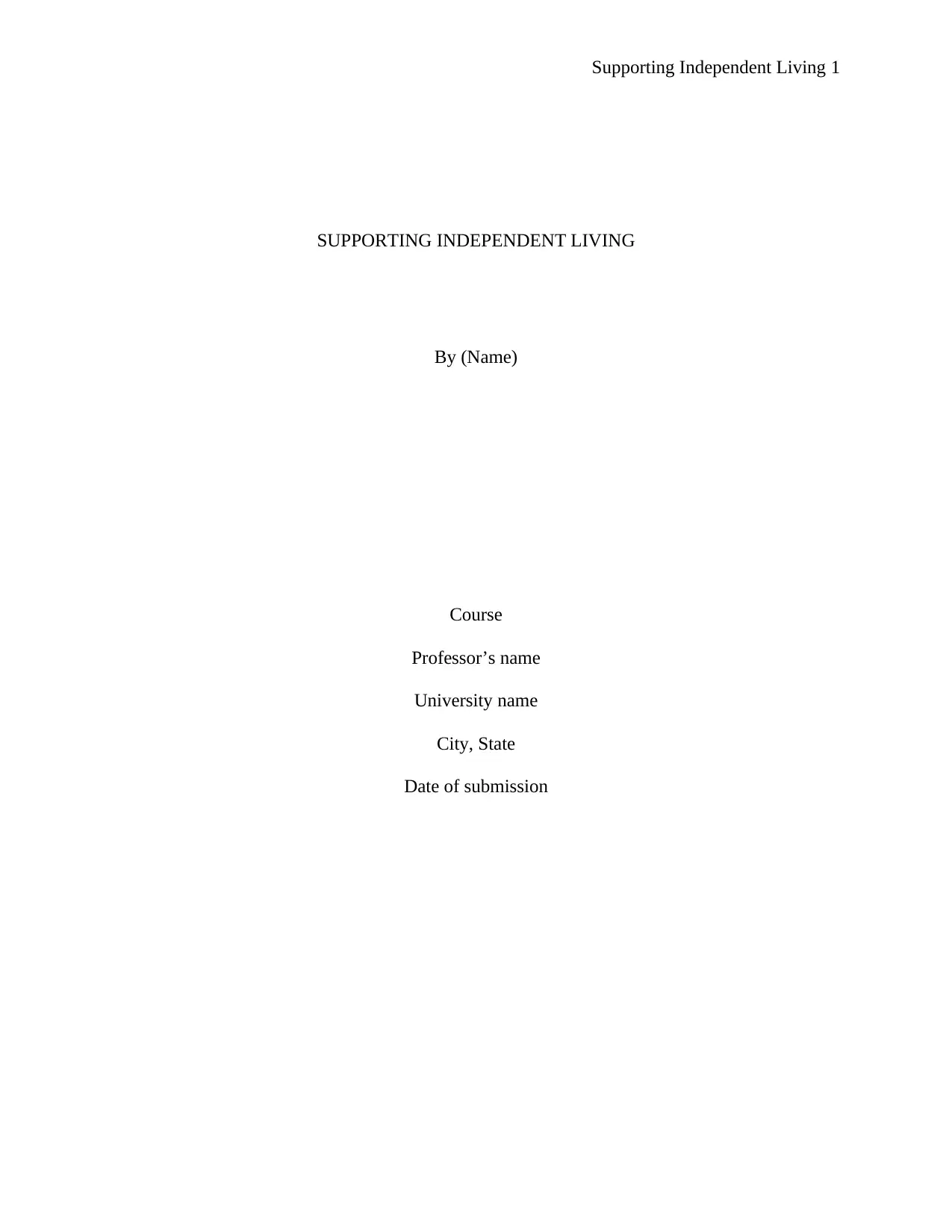
Supporting Independent Living 1
SUPPORTING INDEPENDENT LIVING
By (Name)
Course
Professor’s name
University name
City, State
Date of submission
SUPPORTING INDEPENDENT LIVING
By (Name)
Course
Professor’s name
University name
City, State
Date of submission
Paraphrase This Document
Need a fresh take? Get an instant paraphrase of this document with our AI Paraphraser
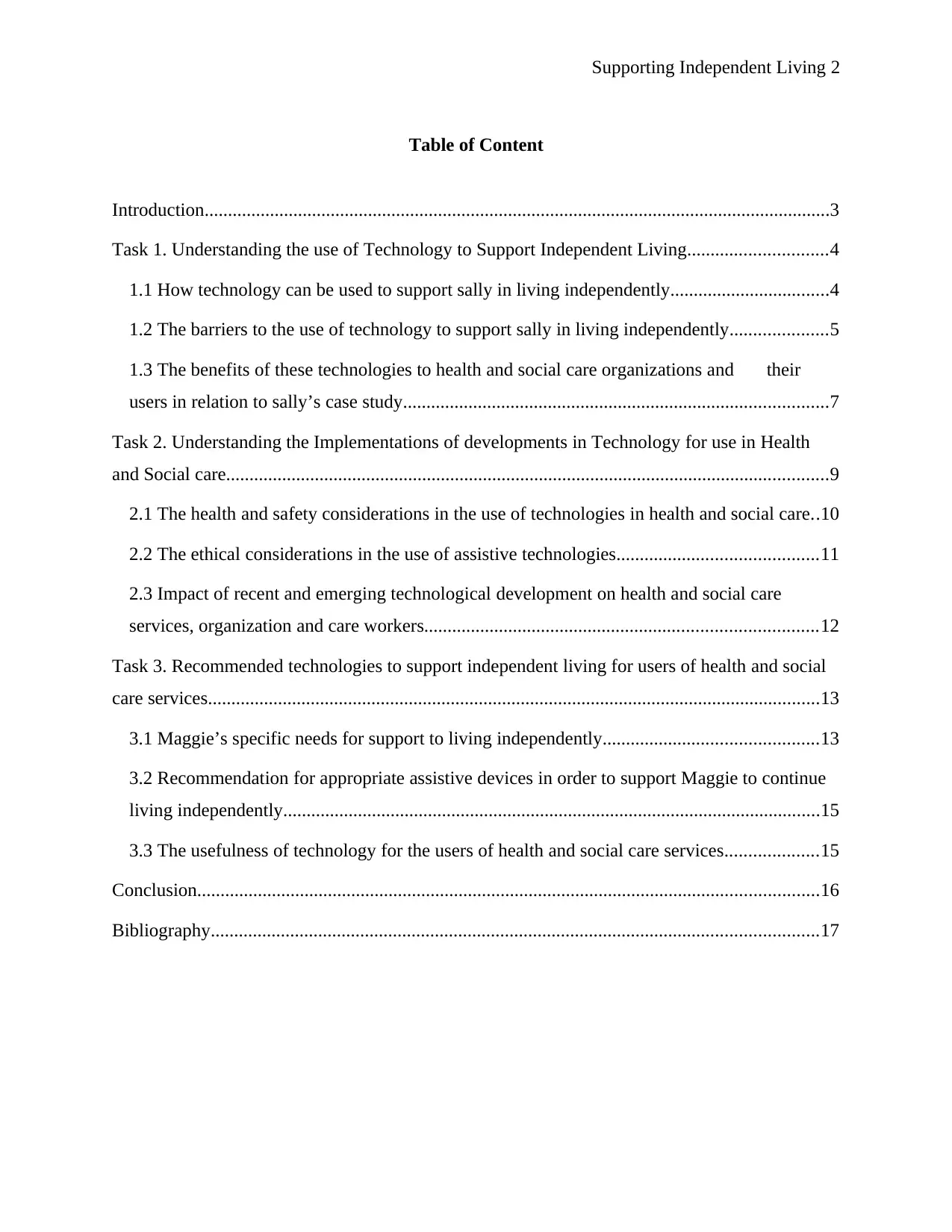
Supporting Independent Living 2
Table of Content
Introduction......................................................................................................................................3
Task 1. Understanding the use of Technology to Support Independent Living..............................4
1.1 How technology can be used to support sally in living independently..................................4
1.2 The barriers to the use of technology to support sally in living independently.....................5
1.3 The benefits of these technologies to health and social care organizations and their
users in relation to sally’s case study...........................................................................................7
Task 2. Understanding the Implementations of developments in Technology for use in Health
and Social care.................................................................................................................................9
2.1 The health and safety considerations in the use of technologies in health and social care..10
2.2 The ethical considerations in the use of assistive technologies...........................................11
2.3 Impact of recent and emerging technological development on health and social care
services, organization and care workers....................................................................................12
Task 3. Recommended technologies to support independent living for users of health and social
care services...................................................................................................................................13
3.1 Maggie’s specific needs for support to living independently..............................................13
3.2 Recommendation for appropriate assistive devices in order to support Maggie to continue
living independently...................................................................................................................15
3.3 The usefulness of technology for the users of health and social care services....................15
Conclusion.....................................................................................................................................16
Bibliography..................................................................................................................................17
Table of Content
Introduction......................................................................................................................................3
Task 1. Understanding the use of Technology to Support Independent Living..............................4
1.1 How technology can be used to support sally in living independently..................................4
1.2 The barriers to the use of technology to support sally in living independently.....................5
1.3 The benefits of these technologies to health and social care organizations and their
users in relation to sally’s case study...........................................................................................7
Task 2. Understanding the Implementations of developments in Technology for use in Health
and Social care.................................................................................................................................9
2.1 The health and safety considerations in the use of technologies in health and social care..10
2.2 The ethical considerations in the use of assistive technologies...........................................11
2.3 Impact of recent and emerging technological development on health and social care
services, organization and care workers....................................................................................12
Task 3. Recommended technologies to support independent living for users of health and social
care services...................................................................................................................................13
3.1 Maggie’s specific needs for support to living independently..............................................13
3.2 Recommendation for appropriate assistive devices in order to support Maggie to continue
living independently...................................................................................................................15
3.3 The usefulness of technology for the users of health and social care services....................15
Conclusion.....................................................................................................................................16
Bibliography..................................................................................................................................17
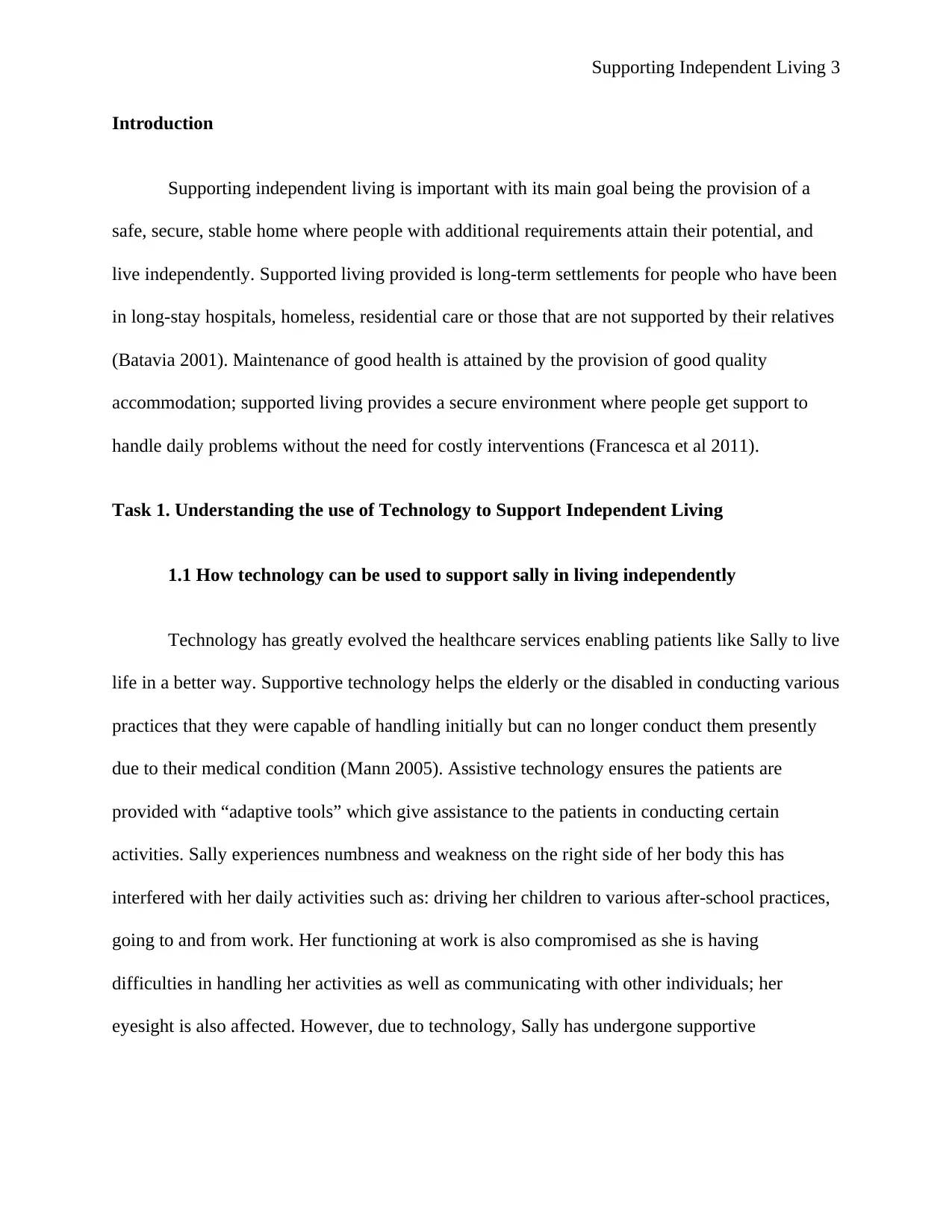
Supporting Independent Living 3
Introduction
Supporting independent living is important with its main goal being the provision of a
safe, secure, stable home where people with additional requirements attain their potential, and
live independently. Supported living provided is long-term settlements for people who have been
in long-stay hospitals, homeless, residential care or those that are not supported by their relatives
(Batavia 2001). Maintenance of good health is attained by the provision of good quality
accommodation; supported living provides a secure environment where people get support to
handle daily problems without the need for costly interventions (Francesca et al 2011).
Task 1. Understanding the use of Technology to Support Independent Living
1.1 How technology can be used to support sally in living independently
Technology has greatly evolved the healthcare services enabling patients like Sally to live
life in a better way. Supportive technology helps the elderly or the disabled in conducting various
practices that they were capable of handling initially but can no longer conduct them presently
due to their medical condition (Mann 2005). Assistive technology ensures the patients are
provided with “adaptive tools” which give assistance to the patients in conducting certain
activities. Sally experiences numbness and weakness on the right side of her body this has
interfered with her daily activities such as: driving her children to various after-school practices,
going to and from work. Her functioning at work is also compromised as she is having
difficulties in handling her activities as well as communicating with other individuals; her
eyesight is also affected. However, due to technology, Sally has undergone supportive
Introduction
Supporting independent living is important with its main goal being the provision of a
safe, secure, stable home where people with additional requirements attain their potential, and
live independently. Supported living provided is long-term settlements for people who have been
in long-stay hospitals, homeless, residential care or those that are not supported by their relatives
(Batavia 2001). Maintenance of good health is attained by the provision of good quality
accommodation; supported living provides a secure environment where people get support to
handle daily problems without the need for costly interventions (Francesca et al 2011).
Task 1. Understanding the use of Technology to Support Independent Living
1.1 How technology can be used to support sally in living independently
Technology has greatly evolved the healthcare services enabling patients like Sally to live
life in a better way. Supportive technology helps the elderly or the disabled in conducting various
practices that they were capable of handling initially but can no longer conduct them presently
due to their medical condition (Mann 2005). Assistive technology ensures the patients are
provided with “adaptive tools” which give assistance to the patients in conducting certain
activities. Sally experiences numbness and weakness on the right side of her body this has
interfered with her daily activities such as: driving her children to various after-school practices,
going to and from work. Her functioning at work is also compromised as she is having
difficulties in handling her activities as well as communicating with other individuals; her
eyesight is also affected. However, due to technology, Sally has undergone supportive
⊘ This is a preview!⊘
Do you want full access?
Subscribe today to unlock all pages.

Trusted by 1+ million students worldwide
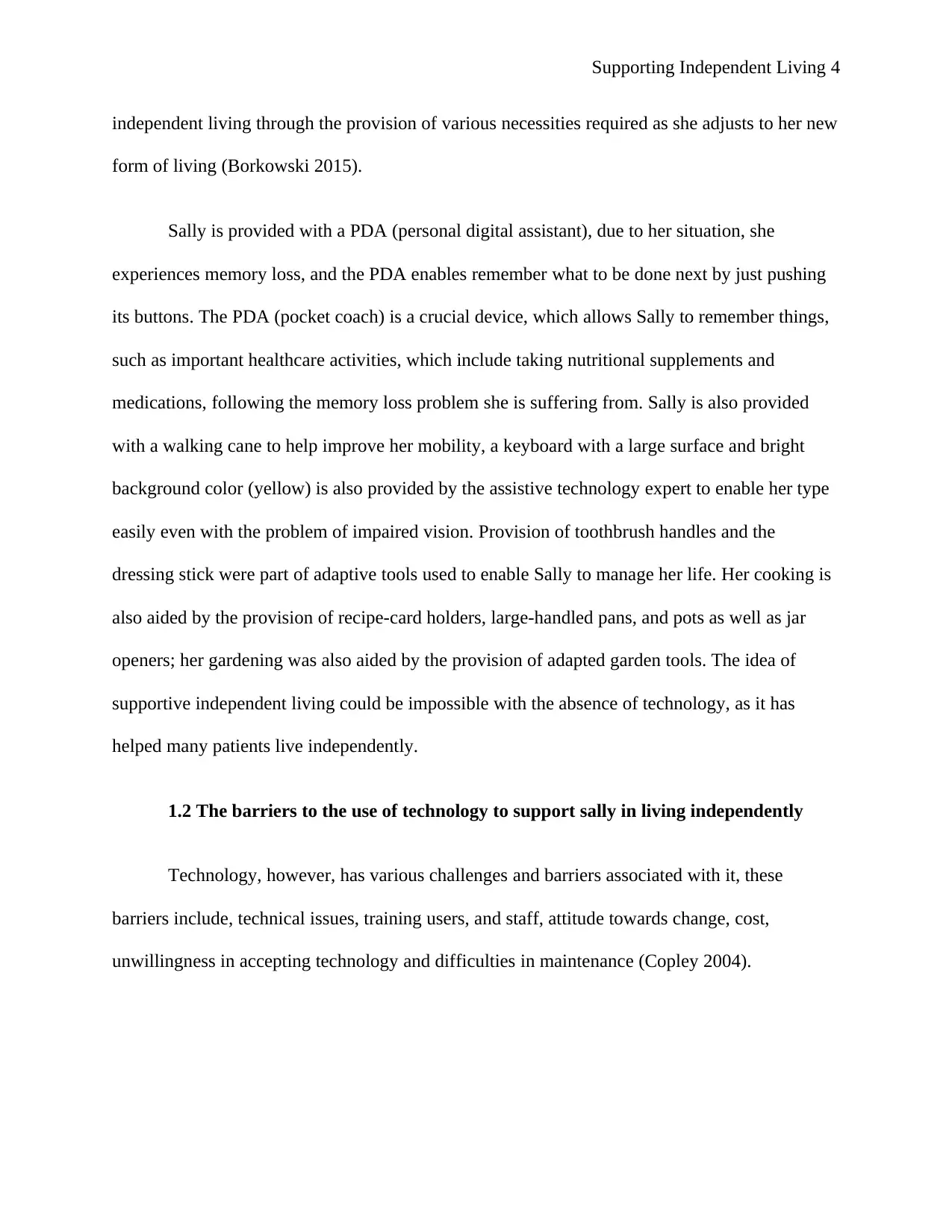
Supporting Independent Living 4
independent living through the provision of various necessities required as she adjusts to her new
form of living (Borkowski 2015).
Sally is provided with a PDA (personal digital assistant), due to her situation, she
experiences memory loss, and the PDA enables remember what to be done next by just pushing
its buttons. The PDA (pocket coach) is a crucial device, which allows Sally to remember things,
such as important healthcare activities, which include taking nutritional supplements and
medications, following the memory loss problem she is suffering from. Sally is also provided
with a walking cane to help improve her mobility, a keyboard with a large surface and bright
background color (yellow) is also provided by the assistive technology expert to enable her type
easily even with the problem of impaired vision. Provision of toothbrush handles and the
dressing stick were part of adaptive tools used to enable Sally to manage her life. Her cooking is
also aided by the provision of recipe-card holders, large-handled pans, and pots as well as jar
openers; her gardening was also aided by the provision of adapted garden tools. The idea of
supportive independent living could be impossible with the absence of technology, as it has
helped many patients live independently.
1.2 The barriers to the use of technology to support sally in living independently
Technology, however, has various challenges and barriers associated with it, these
barriers include, technical issues, training users, and staff, attitude towards change, cost,
unwillingness in accepting technology and difficulties in maintenance (Copley 2004).
independent living through the provision of various necessities required as she adjusts to her new
form of living (Borkowski 2015).
Sally is provided with a PDA (personal digital assistant), due to her situation, she
experiences memory loss, and the PDA enables remember what to be done next by just pushing
its buttons. The PDA (pocket coach) is a crucial device, which allows Sally to remember things,
such as important healthcare activities, which include taking nutritional supplements and
medications, following the memory loss problem she is suffering from. Sally is also provided
with a walking cane to help improve her mobility, a keyboard with a large surface and bright
background color (yellow) is also provided by the assistive technology expert to enable her type
easily even with the problem of impaired vision. Provision of toothbrush handles and the
dressing stick were part of adaptive tools used to enable Sally to manage her life. Her cooking is
also aided by the provision of recipe-card holders, large-handled pans, and pots as well as jar
openers; her gardening was also aided by the provision of adapted garden tools. The idea of
supportive independent living could be impossible with the absence of technology, as it has
helped many patients live independently.
1.2 The barriers to the use of technology to support sally in living independently
Technology, however, has various challenges and barriers associated with it, these
barriers include, technical issues, training users, and staff, attitude towards change, cost,
unwillingness in accepting technology and difficulties in maintenance (Copley 2004).
Paraphrase This Document
Need a fresh take? Get an instant paraphrase of this document with our AI Paraphraser
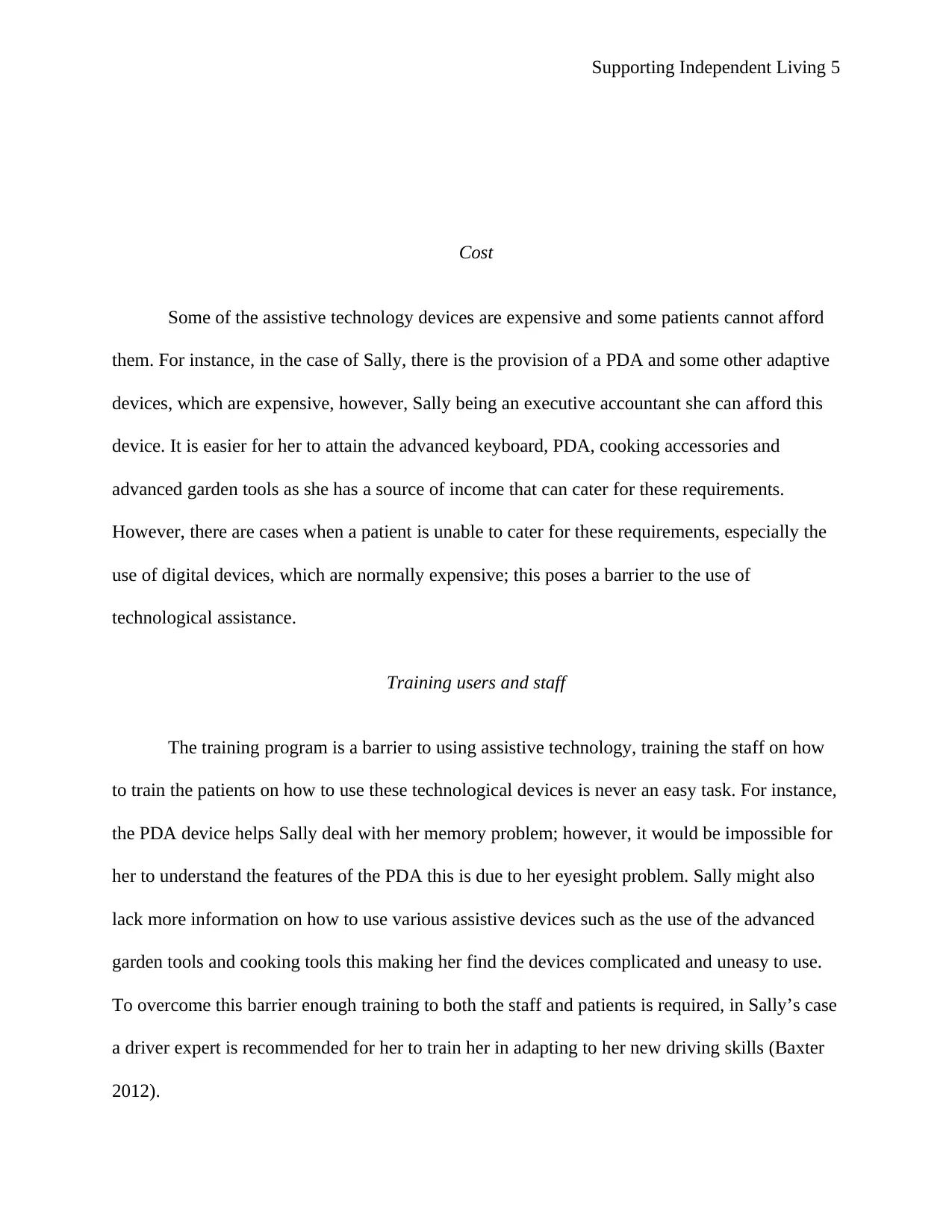
Supporting Independent Living 5
Cost
Some of the assistive technology devices are expensive and some patients cannot afford
them. For instance, in the case of Sally, there is the provision of a PDA and some other adaptive
devices, which are expensive, however, Sally being an executive accountant she can afford this
device. It is easier for her to attain the advanced keyboard, PDA, cooking accessories and
advanced garden tools as she has a source of income that can cater for these requirements.
However, there are cases when a patient is unable to cater for these requirements, especially the
use of digital devices, which are normally expensive; this poses a barrier to the use of
technological assistance.
Training users and staff
The training program is a barrier to using assistive technology, training the staff on how
to train the patients on how to use these technological devices is never an easy task. For instance,
the PDA device helps Sally deal with her memory problem; however, it would be impossible for
her to understand the features of the PDA this is due to her eyesight problem. Sally might also
lack more information on how to use various assistive devices such as the use of the advanced
garden tools and cooking tools this making her find the devices complicated and uneasy to use.
To overcome this barrier enough training to both the staff and patients is required, in Sally’s case
a driver expert is recommended for her to train her in adapting to her new driving skills (Baxter
2012).
Cost
Some of the assistive technology devices are expensive and some patients cannot afford
them. For instance, in the case of Sally, there is the provision of a PDA and some other adaptive
devices, which are expensive, however, Sally being an executive accountant she can afford this
device. It is easier for her to attain the advanced keyboard, PDA, cooking accessories and
advanced garden tools as she has a source of income that can cater for these requirements.
However, there are cases when a patient is unable to cater for these requirements, especially the
use of digital devices, which are normally expensive; this poses a barrier to the use of
technological assistance.
Training users and staff
The training program is a barrier to using assistive technology, training the staff on how
to train the patients on how to use these technological devices is never an easy task. For instance,
the PDA device helps Sally deal with her memory problem; however, it would be impossible for
her to understand the features of the PDA this is due to her eyesight problem. Sally might also
lack more information on how to use various assistive devices such as the use of the advanced
garden tools and cooking tools this making her find the devices complicated and uneasy to use.
To overcome this barrier enough training to both the staff and patients is required, in Sally’s case
a driver expert is recommended for her to train her in adapting to her new driving skills (Baxter
2012).
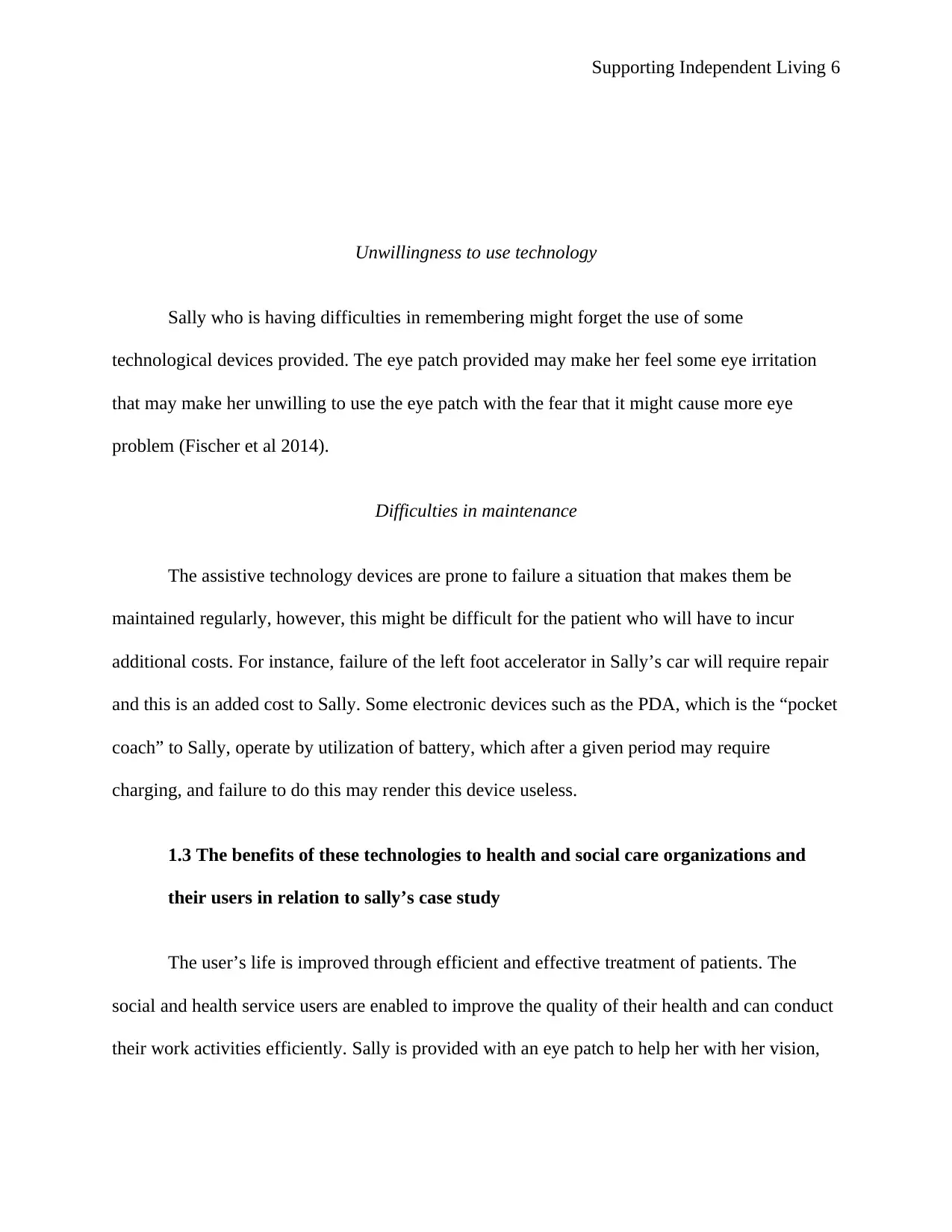
Supporting Independent Living 6
Unwillingness to use technology
Sally who is having difficulties in remembering might forget the use of some
technological devices provided. The eye patch provided may make her feel some eye irritation
that may make her unwilling to use the eye patch with the fear that it might cause more eye
problem (Fischer et al 2014).
Difficulties in maintenance
The assistive technology devices are prone to failure a situation that makes them be
maintained regularly, however, this might be difficult for the patient who will have to incur
additional costs. For instance, failure of the left foot accelerator in Sally’s car will require repair
and this is an added cost to Sally. Some electronic devices such as the PDA, which is the “pocket
coach” to Sally, operate by utilization of battery, which after a given period may require
charging, and failure to do this may render this device useless.
1.3 The benefits of these technologies to health and social care organizations and
their users in relation to sally’s case study
The user’s life is improved through efficient and effective treatment of patients. The
social and health service users are enabled to improve the quality of their health and can conduct
their work activities efficiently. Sally is provided with an eye patch to help her with her vision,
Unwillingness to use technology
Sally who is having difficulties in remembering might forget the use of some
technological devices provided. The eye patch provided may make her feel some eye irritation
that may make her unwilling to use the eye patch with the fear that it might cause more eye
problem (Fischer et al 2014).
Difficulties in maintenance
The assistive technology devices are prone to failure a situation that makes them be
maintained regularly, however, this might be difficult for the patient who will have to incur
additional costs. For instance, failure of the left foot accelerator in Sally’s car will require repair
and this is an added cost to Sally. Some electronic devices such as the PDA, which is the “pocket
coach” to Sally, operate by utilization of battery, which after a given period may require
charging, and failure to do this may render this device useless.
1.3 The benefits of these technologies to health and social care organizations and
their users in relation to sally’s case study
The user’s life is improved through efficient and effective treatment of patients. The
social and health service users are enabled to improve the quality of their health and can conduct
their work activities efficiently. Sally is provided with an eye patch to help her with her vision,
⊘ This is a preview!⊘
Do you want full access?
Subscribe today to unlock all pages.

Trusted by 1+ million students worldwide
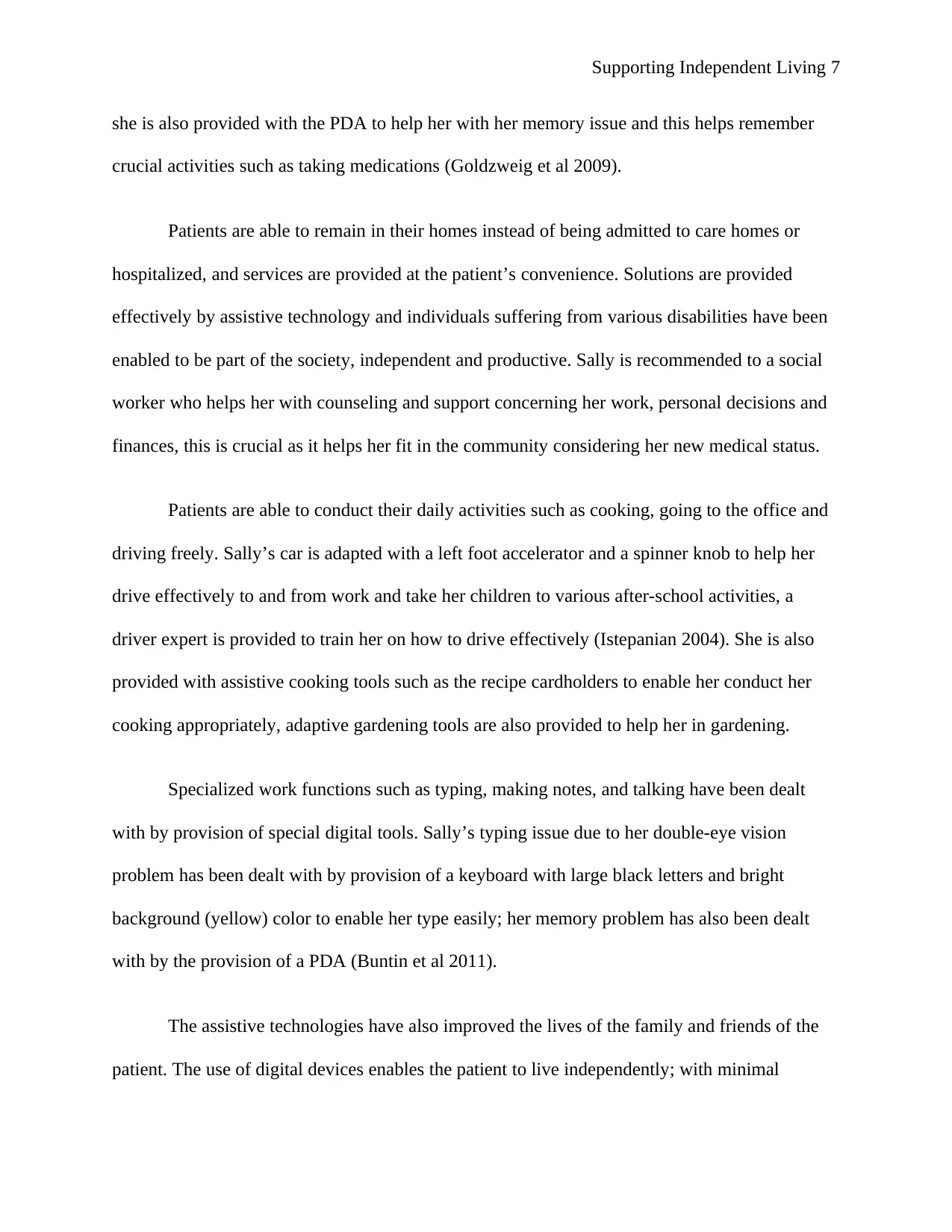
Supporting Independent Living 7
she is also provided with the PDA to help her with her memory issue and this helps remember
crucial activities such as taking medications (Goldzweig et al 2009).
Patients are able to remain in their homes instead of being admitted to care homes or
hospitalized, and services are provided at the patient’s convenience. Solutions are provided
effectively by assistive technology and individuals suffering from various disabilities have been
enabled to be part of the society, independent and productive. Sally is recommended to a social
worker who helps her with counseling and support concerning her work, personal decisions and
finances, this is crucial as it helps her fit in the community considering her new medical status.
Patients are able to conduct their daily activities such as cooking, going to the office and
driving freely. Sally’s car is adapted with a left foot accelerator and a spinner knob to help her
drive effectively to and from work and take her children to various after-school activities, a
driver expert is provided to train her on how to drive effectively (Istepanian 2004). She is also
provided with assistive cooking tools such as the recipe cardholders to enable her conduct her
cooking appropriately, adaptive gardening tools are also provided to help her in gardening.
Specialized work functions such as typing, making notes, and talking have been dealt
with by provision of special digital tools. Sally’s typing issue due to her double-eye vision
problem has been dealt with by provision of a keyboard with large black letters and bright
background (yellow) color to enable her type easily; her memory problem has also been dealt
with by the provision of a PDA (Buntin et al 2011).
The assistive technologies have also improved the lives of the family and friends of the
patient. The use of digital devices enables the patient to live independently; with minimal
she is also provided with the PDA to help her with her memory issue and this helps remember
crucial activities such as taking medications (Goldzweig et al 2009).
Patients are able to remain in their homes instead of being admitted to care homes or
hospitalized, and services are provided at the patient’s convenience. Solutions are provided
effectively by assistive technology and individuals suffering from various disabilities have been
enabled to be part of the society, independent and productive. Sally is recommended to a social
worker who helps her with counseling and support concerning her work, personal decisions and
finances, this is crucial as it helps her fit in the community considering her new medical status.
Patients are able to conduct their daily activities such as cooking, going to the office and
driving freely. Sally’s car is adapted with a left foot accelerator and a spinner knob to help her
drive effectively to and from work and take her children to various after-school activities, a
driver expert is provided to train her on how to drive effectively (Istepanian 2004). She is also
provided with assistive cooking tools such as the recipe cardholders to enable her conduct her
cooking appropriately, adaptive gardening tools are also provided to help her in gardening.
Specialized work functions such as typing, making notes, and talking have been dealt
with by provision of special digital tools. Sally’s typing issue due to her double-eye vision
problem has been dealt with by provision of a keyboard with large black letters and bright
background (yellow) color to enable her type easily; her memory problem has also been dealt
with by the provision of a PDA (Buntin et al 2011).
The assistive technologies have also improved the lives of the family and friends of the
patient. The use of digital devices enables the patient to live independently; with minimal
Paraphrase This Document
Need a fresh take? Get an instant paraphrase of this document with our AI Paraphraser
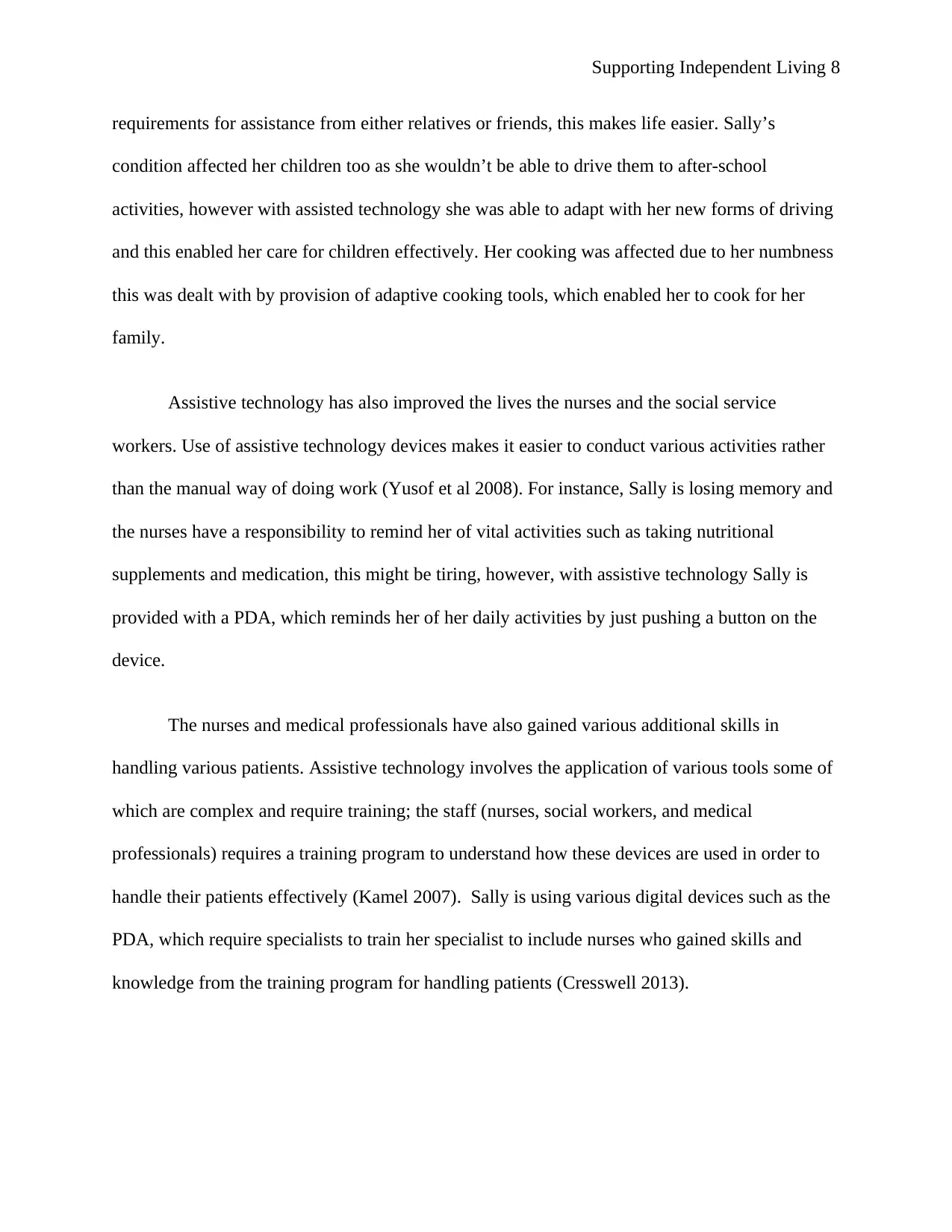
Supporting Independent Living 8
requirements for assistance from either relatives or friends, this makes life easier. Sally’s
condition affected her children too as she wouldn’t be able to drive them to after-school
activities, however with assisted technology she was able to adapt with her new forms of driving
and this enabled her care for children effectively. Her cooking was affected due to her numbness
this was dealt with by provision of adaptive cooking tools, which enabled her to cook for her
family.
Assistive technology has also improved the lives the nurses and the social service
workers. Use of assistive technology devices makes it easier to conduct various activities rather
than the manual way of doing work (Yusof et al 2008). For instance, Sally is losing memory and
the nurses have a responsibility to remind her of vital activities such as taking nutritional
supplements and medication, this might be tiring, however, with assistive technology Sally is
provided with a PDA, which reminds her of her daily activities by just pushing a button on the
device.
The nurses and medical professionals have also gained various additional skills in
handling various patients. Assistive technology involves the application of various tools some of
which are complex and require training; the staff (nurses, social workers, and medical
professionals) requires a training program to understand how these devices are used in order to
handle their patients effectively (Kamel 2007). Sally is using various digital devices such as the
PDA, which require specialists to train her specialist to include nurses who gained skills and
knowledge from the training program for handling patients (Cresswell 2013).
requirements for assistance from either relatives or friends, this makes life easier. Sally’s
condition affected her children too as she wouldn’t be able to drive them to after-school
activities, however with assisted technology she was able to adapt with her new forms of driving
and this enabled her care for children effectively. Her cooking was affected due to her numbness
this was dealt with by provision of adaptive cooking tools, which enabled her to cook for her
family.
Assistive technology has also improved the lives the nurses and the social service
workers. Use of assistive technology devices makes it easier to conduct various activities rather
than the manual way of doing work (Yusof et al 2008). For instance, Sally is losing memory and
the nurses have a responsibility to remind her of vital activities such as taking nutritional
supplements and medication, this might be tiring, however, with assistive technology Sally is
provided with a PDA, which reminds her of her daily activities by just pushing a button on the
device.
The nurses and medical professionals have also gained various additional skills in
handling various patients. Assistive technology involves the application of various tools some of
which are complex and require training; the staff (nurses, social workers, and medical
professionals) requires a training program to understand how these devices are used in order to
handle their patients effectively (Kamel 2007). Sally is using various digital devices such as the
PDA, which require specialists to train her specialist to include nurses who gained skills and
knowledge from the training program for handling patients (Cresswell 2013).
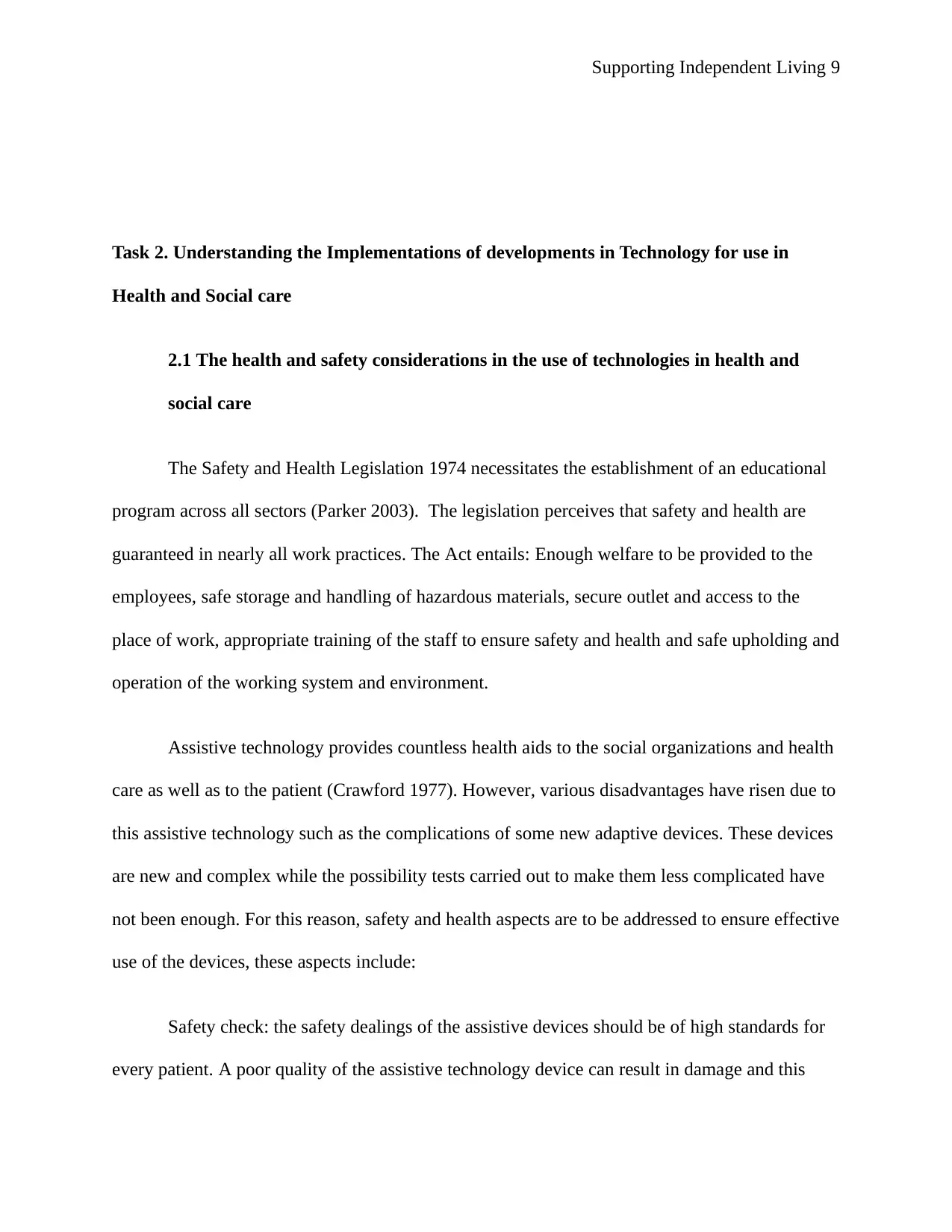
Supporting Independent Living 9
Task 2. Understanding the Implementations of developments in Technology for use in
Health and Social care
2.1 The health and safety considerations in the use of technologies in health and
social care
The Safety and Health Legislation 1974 necessitates the establishment of an educational
program across all sectors (Parker 2003). The legislation perceives that safety and health are
guaranteed in nearly all work practices. The Act entails: Enough welfare to be provided to the
employees, safe storage and handling of hazardous materials, secure outlet and access to the
place of work, appropriate training of the staff to ensure safety and health and safe upholding and
operation of the working system and environment.
Assistive technology provides countless health aids to the social organizations and health
care as well as to the patient (Crawford 1977). However, various disadvantages have risen due to
this assistive technology such as the complications of some new adaptive devices. These devices
are new and complex while the possibility tests carried out to make them less complicated have
not been enough. For this reason, safety and health aspects are to be addressed to ensure effective
use of the devices, these aspects include:
Safety check: the safety dealings of the assistive devices should be of high standards for
every patient. A poor quality of the assistive technology device can result in damage and this
Task 2. Understanding the Implementations of developments in Technology for use in
Health and Social care
2.1 The health and safety considerations in the use of technologies in health and
social care
The Safety and Health Legislation 1974 necessitates the establishment of an educational
program across all sectors (Parker 2003). The legislation perceives that safety and health are
guaranteed in nearly all work practices. The Act entails: Enough welfare to be provided to the
employees, safe storage and handling of hazardous materials, secure outlet and access to the
place of work, appropriate training of the staff to ensure safety and health and safe upholding and
operation of the working system and environment.
Assistive technology provides countless health aids to the social organizations and health
care as well as to the patient (Crawford 1977). However, various disadvantages have risen due to
this assistive technology such as the complications of some new adaptive devices. These devices
are new and complex while the possibility tests carried out to make them less complicated have
not been enough. For this reason, safety and health aspects are to be addressed to ensure effective
use of the devices, these aspects include:
Safety check: the safety dealings of the assistive devices should be of high standards for
every patient. A poor quality of the assistive technology device can result in damage and this
⊘ This is a preview!⊘
Do you want full access?
Subscribe today to unlock all pages.

Trusted by 1+ million students worldwide
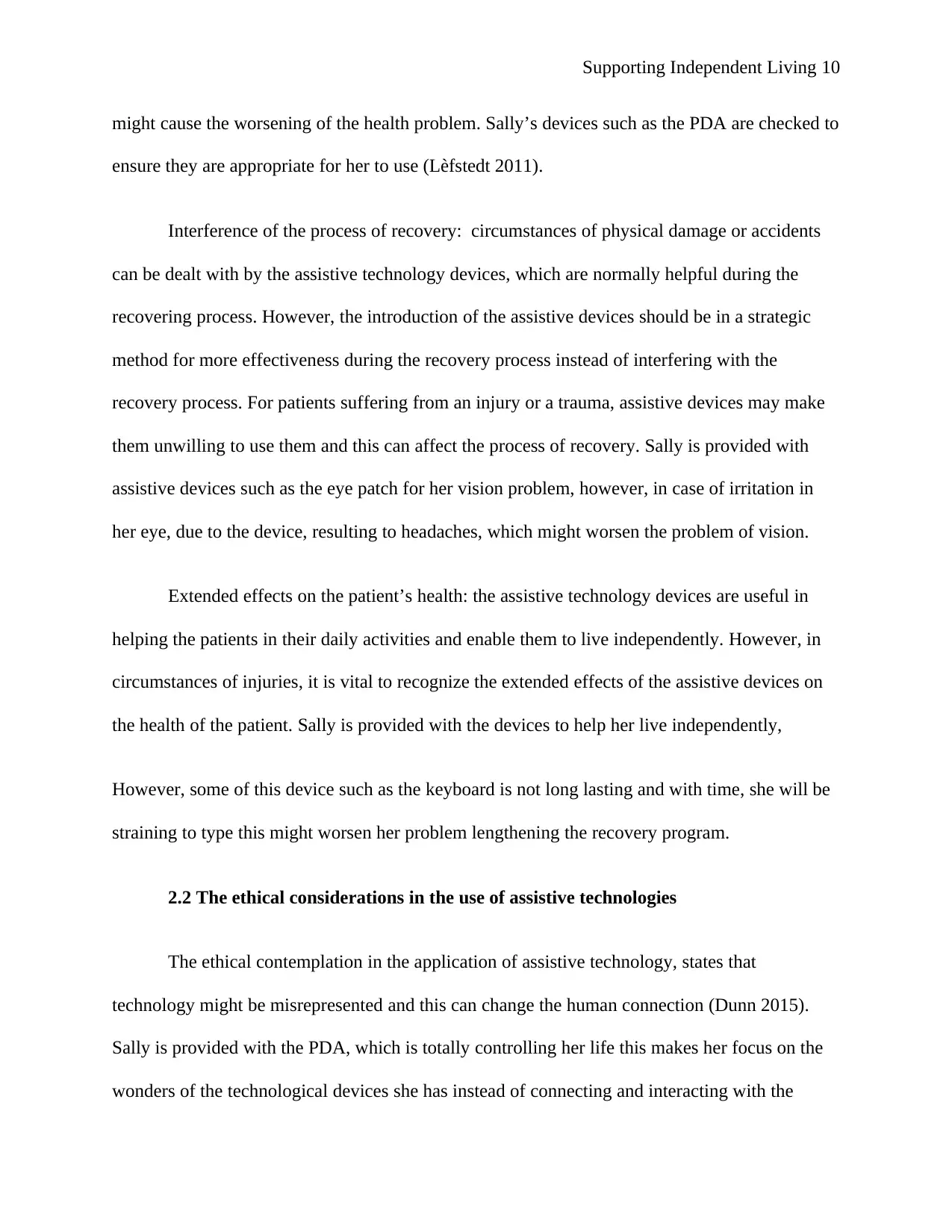
Supporting Independent Living 10
might cause the worsening of the health problem. Sally’s devices such as the PDA are checked to
ensure they are appropriate for her to use (Lèfstedt 2011).
Interference of the process of recovery: circumstances of physical damage or accidents
can be dealt with by the assistive technology devices, which are normally helpful during the
recovering process. However, the introduction of the assistive devices should be in a strategic
method for more effectiveness during the recovery process instead of interfering with the
recovery process. For patients suffering from an injury or a trauma, assistive devices may make
them unwilling to use them and this can affect the process of recovery. Sally is provided with
assistive devices such as the eye patch for her vision problem, however, in case of irritation in
her eye, due to the device, resulting to headaches, which might worsen the problem of vision.
Extended effects on the patient’s health: the assistive technology devices are useful in
helping the patients in their daily activities and enable them to live independently. However, in
circumstances of injuries, it is vital to recognize the extended effects of the assistive devices on
the health of the patient. Sally is provided with the devices to help her live independently,
However, some of this device such as the keyboard is not long lasting and with time, she will be
straining to type this might worsen her problem lengthening the recovery program.
2.2 The ethical considerations in the use of assistive technologies
The ethical contemplation in the application of assistive technology, states that
technology might be misrepresented and this can change the human connection (Dunn 2015).
Sally is provided with the PDA, which is totally controlling her life this makes her focus on the
wonders of the technological devices she has instead of connecting and interacting with the
might cause the worsening of the health problem. Sally’s devices such as the PDA are checked to
ensure they are appropriate for her to use (Lèfstedt 2011).
Interference of the process of recovery: circumstances of physical damage or accidents
can be dealt with by the assistive technology devices, which are normally helpful during the
recovering process. However, the introduction of the assistive devices should be in a strategic
method for more effectiveness during the recovery process instead of interfering with the
recovery process. For patients suffering from an injury or a trauma, assistive devices may make
them unwilling to use them and this can affect the process of recovery. Sally is provided with
assistive devices such as the eye patch for her vision problem, however, in case of irritation in
her eye, due to the device, resulting to headaches, which might worsen the problem of vision.
Extended effects on the patient’s health: the assistive technology devices are useful in
helping the patients in their daily activities and enable them to live independently. However, in
circumstances of injuries, it is vital to recognize the extended effects of the assistive devices on
the health of the patient. Sally is provided with the devices to help her live independently,
However, some of this device such as the keyboard is not long lasting and with time, she will be
straining to type this might worsen her problem lengthening the recovery program.
2.2 The ethical considerations in the use of assistive technologies
The ethical contemplation in the application of assistive technology, states that
technology might be misrepresented and this can change the human connection (Dunn 2015).
Sally is provided with the PDA, which is totally controlling her life this makes her focus on the
wonders of the technological devices she has instead of connecting and interacting with the
Paraphrase This Document
Need a fresh take? Get an instant paraphrase of this document with our AI Paraphraser
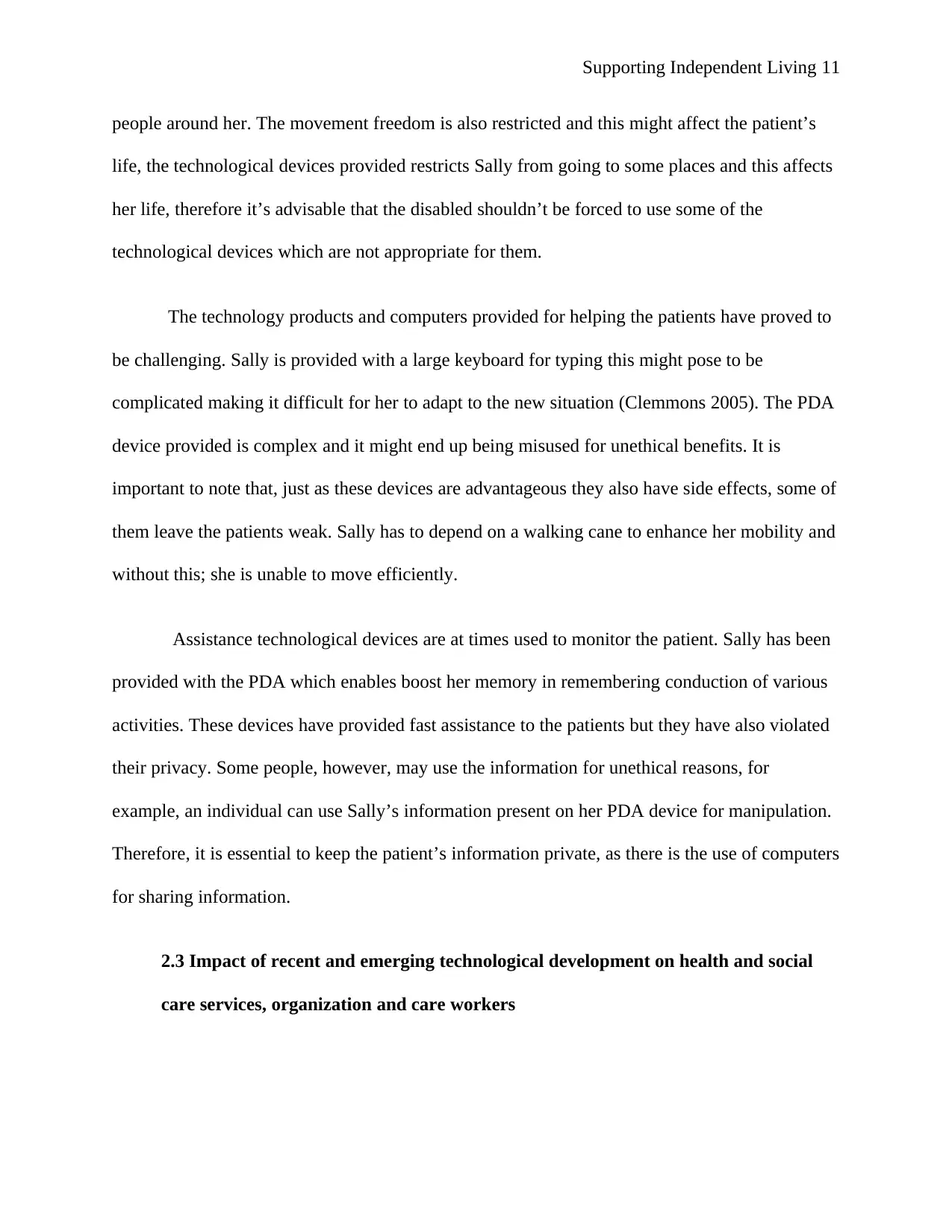
Supporting Independent Living 11
people around her. The movement freedom is also restricted and this might affect the patient’s
life, the technological devices provided restricts Sally from going to some places and this affects
her life, therefore it’s advisable that the disabled shouldn’t be forced to use some of the
technological devices which are not appropriate for them.
The technology products and computers provided for helping the patients have proved to
be challenging. Sally is provided with a large keyboard for typing this might pose to be
complicated making it difficult for her to adapt to the new situation (Clemmons 2005). The PDA
device provided is complex and it might end up being misused for unethical benefits. It is
important to note that, just as these devices are advantageous they also have side effects, some of
them leave the patients weak. Sally has to depend on a walking cane to enhance her mobility and
without this; she is unable to move efficiently.
Assistance technological devices are at times used to monitor the patient. Sally has been
provided with the PDA which enables boost her memory in remembering conduction of various
activities. These devices have provided fast assistance to the patients but they have also violated
their privacy. Some people, however, may use the information for unethical reasons, for
example, an individual can use Sally’s information present on her PDA device for manipulation.
Therefore, it is essential to keep the patient’s information private, as there is the use of computers
for sharing information.
2.3 Impact of recent and emerging technological development on health and social
care services, organization and care workers
people around her. The movement freedom is also restricted and this might affect the patient’s
life, the technological devices provided restricts Sally from going to some places and this affects
her life, therefore it’s advisable that the disabled shouldn’t be forced to use some of the
technological devices which are not appropriate for them.
The technology products and computers provided for helping the patients have proved to
be challenging. Sally is provided with a large keyboard for typing this might pose to be
complicated making it difficult for her to adapt to the new situation (Clemmons 2005). The PDA
device provided is complex and it might end up being misused for unethical benefits. It is
important to note that, just as these devices are advantageous they also have side effects, some of
them leave the patients weak. Sally has to depend on a walking cane to enhance her mobility and
without this; she is unable to move efficiently.
Assistance technological devices are at times used to monitor the patient. Sally has been
provided with the PDA which enables boost her memory in remembering conduction of various
activities. These devices have provided fast assistance to the patients but they have also violated
their privacy. Some people, however, may use the information for unethical reasons, for
example, an individual can use Sally’s information present on her PDA device for manipulation.
Therefore, it is essential to keep the patient’s information private, as there is the use of computers
for sharing information.
2.3 Impact of recent and emerging technological development on health and social
care services, organization and care workers
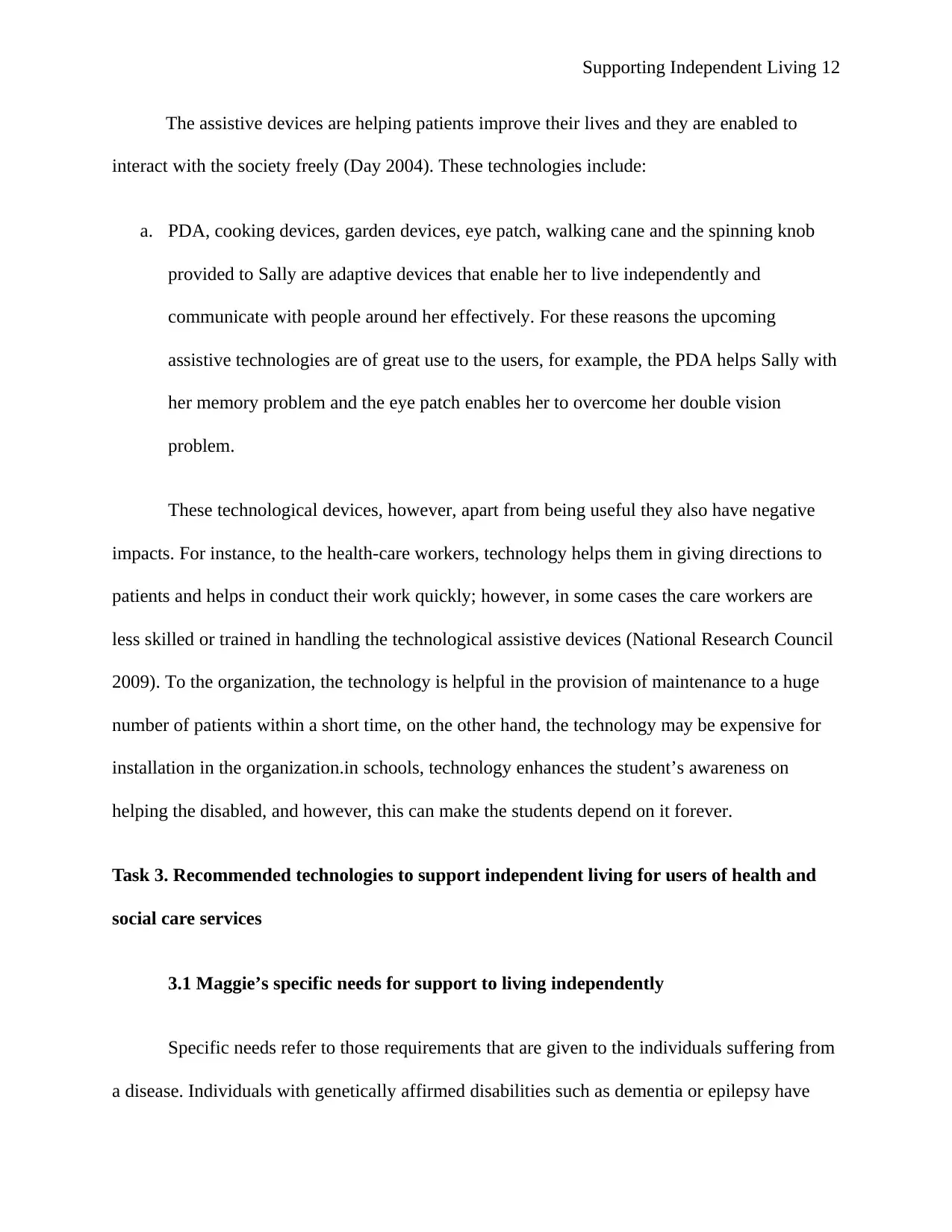
Supporting Independent Living 12
The assistive devices are helping patients improve their lives and they are enabled to
interact with the society freely (Day 2004). These technologies include:
a. PDA, cooking devices, garden devices, eye patch, walking cane and the spinning knob
provided to Sally are adaptive devices that enable her to live independently and
communicate with people around her effectively. For these reasons the upcoming
assistive technologies are of great use to the users, for example, the PDA helps Sally with
her memory problem and the eye patch enables her to overcome her double vision
problem.
These technological devices, however, apart from being useful they also have negative
impacts. For instance, to the health-care workers, technology helps them in giving directions to
patients and helps in conduct their work quickly; however, in some cases the care workers are
less skilled or trained in handling the technological assistive devices (National Research Council
2009). To the organization, the technology is helpful in the provision of maintenance to a huge
number of patients within a short time, on the other hand, the technology may be expensive for
installation in the organization.in schools, technology enhances the student’s awareness on
helping the disabled, and however, this can make the students depend on it forever.
Task 3. Recommended technologies to support independent living for users of health and
social care services
3.1 Maggie’s specific needs for support to living independently
Specific needs refer to those requirements that are given to the individuals suffering from
a disease. Individuals with genetically affirmed disabilities such as dementia or epilepsy have
The assistive devices are helping patients improve their lives and they are enabled to
interact with the society freely (Day 2004). These technologies include:
a. PDA, cooking devices, garden devices, eye patch, walking cane and the spinning knob
provided to Sally are adaptive devices that enable her to live independently and
communicate with people around her effectively. For these reasons the upcoming
assistive technologies are of great use to the users, for example, the PDA helps Sally with
her memory problem and the eye patch enables her to overcome her double vision
problem.
These technological devices, however, apart from being useful they also have negative
impacts. For instance, to the health-care workers, technology helps them in giving directions to
patients and helps in conduct their work quickly; however, in some cases the care workers are
less skilled or trained in handling the technological assistive devices (National Research Council
2009). To the organization, the technology is helpful in the provision of maintenance to a huge
number of patients within a short time, on the other hand, the technology may be expensive for
installation in the organization.in schools, technology enhances the student’s awareness on
helping the disabled, and however, this can make the students depend on it forever.
Task 3. Recommended technologies to support independent living for users of health and
social care services
3.1 Maggie’s specific needs for support to living independently
Specific needs refer to those requirements that are given to the individuals suffering from
a disease. Individuals with genetically affirmed disabilities such as dementia or epilepsy have
⊘ This is a preview!⊘
Do you want full access?
Subscribe today to unlock all pages.

Trusted by 1+ million students worldwide
1 out of 19
Related Documents
Your All-in-One AI-Powered Toolkit for Academic Success.
+13062052269
info@desklib.com
Available 24*7 on WhatsApp / Email
![[object Object]](/_next/static/media/star-bottom.7253800d.svg)
Unlock your academic potential
Copyright © 2020–2025 A2Z Services. All Rights Reserved. Developed and managed by ZUCOL.





